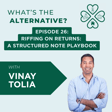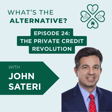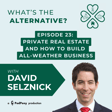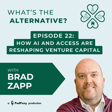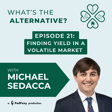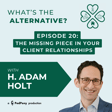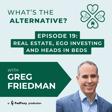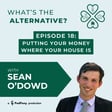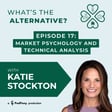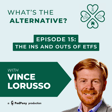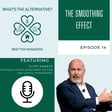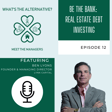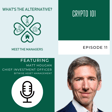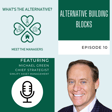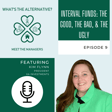Introduction and Podcast Focus
00:00:00
Speaker
You go from a sixty forty to really you get your core betas and then you're going to add the 20% alts without sacrificing your core equities. You know, I think the the equity bond mix was somewhat straightforward in this combination that we're talking about. Like we're doing um some of the capital fishing core ideas with stocks and bonds and, you know, 5% position in the gold overlay. Then we have a little bit of more equities and sort of rounding out the bond futures you get with, know,
00:00:30
Speaker
um just the futures with some of the mortgages and investment grades. So it's a little bit straightforward of a equity bond mix where a lot of the, I'd say, um stuff that separates this model portfolio collaboration is in the alts, right? So I think we did a lot of work. You are first alts partnership in
WisdomTree and Bonrian Capital Collaboration
00:00:50
Speaker
this space. So it's a big testament to, I think, all the work that you've done here and that you're really thinking about this on a day-to-day basis and that you've got to explain
00:01:09
Speaker
I am Shana Orzek Sissel, founder and CEO of Bondering Capital Management. And this is the podcast where we dive deep into the weeds of alternative investments with leading experts.
00:01:20
Speaker
Today, we have a great guest. I'm super excited about this particular guest because we have some really cool things that we're going to be announcing. as it relates to their firm and our firm.
00:01:32
Speaker
I have with us Jeremy Schwartz. He is the Global Chief Investment Officer at WisdomTree and has been since November of 2021. But he's been with WisdomTree since 2020, 2005.
00:01:46
Speaker
And as he informed me right before we went live, he is the second second longest employee at the firm other than the CEO. So welcome, Jeremy. So excited to have you.
00:01:58
Speaker
Shayna, always love doing these podcasts, particularly when we have some news to announce. So this is great to be with you. Thanks so much for having me. Absolutely. Super excited about it. All right. So let's just get started.
Understanding Return Stacking and Leverage
00:02:10
Speaker
um I'm really excited to have you on because ah as some people know, but we haven't publicly talked about it, WisdomTree and Bonrian have teamed up to put together a open architecture,
00:02:26
Speaker
alternative ETF model that's part of a broader program that WisdomTree is launching ah involving return stacking. And I talk about return stacking quite a bit, but the term is a fairly new one.
00:02:37
Speaker
And I would love it if you could kind of walk us through WisdomTree's thought process here, are the commitment to the space and how alternatives fit in. Yeah, and I think in the active world, you've seen the use of leverage and these these kind of strategies for a long time. i know you know there's been actively managed bond portfolios where they try to add some returns on on trying get short-term fixed income, and then they layer on equity swaps, and they're just trying to outperform the funding costs of the swap or the future.
00:03:08
Speaker
that's how they add 1%, 2% of quote-unquote alpha on top of equities. That's been done you know for for a long time There's other combinations where they combine that type of concept.
00:03:20
Speaker
We were the first firm, I think, to do it with beta instruments using basically stock and bond futures. So seven or eight years ago, a lot of it generated from a conversation that I saw on Twitter back in the day. So a few anonymous people and Corey Hofstein were talking about, hey, there needs to be innovation in ETFs with leverage where you where you can provide these betas in a stock and bond mix.
00:03:43
Speaker
And there was a conversation about like, what's the optimal ratio? But the conversation went to 90, 60 or like one a half times 60, 40. And that original idea was two thirds of a 90, 60 gets you a 60, 40.
00:03:56
Speaker
And then you have one third of your portfolio freed up for alternatives. It's like, well, if you're going to put in an alternative, where do you fund it from? What do you sell? Like, you know, you're putting in this sort of complex instrument. and It's always tough to figure out what to sell. And this was the idea where you could have both, where you could do that. so we launched three versions of that, sort US-International merging.
00:04:14
Speaker
We probably have almost, well, combined our whole suite, probably over $2 billion dollars in the concepts. We later did gold with gold on top of things like large cap equities and more of a 90-90 conversation. And it may be maybe one of my favorite days in my 20 years of history is when we first launched it. The day we launched it,
00:04:36
Speaker
seven or eight years ago, ah you know we we put it out and and Cliff Astness wrote out, I had a 25 year head start on on Wisdom Tree and they still beat me to it. And so it's been like a nice relationship with Cliff who actually wrote a paper in 96, where he had 70 years of history looking at the leverage 60, 40, doing better than 100% equities. And you know his leverage ratio in that paper was like 1.55. It was like exactly the 90, 60.
00:05:03
Speaker
And so we you know he was being very gracious. we that, you know, further went back and re looked at his research, extended it and said, yeah, you know, a lot of research fails out a sample. But if you were to do his research in the 30 years since he published the paper, it's worked better.
00:05:18
Speaker
And then in the third in the actual 30 years after he publishes not only did it, failed it it did better than failed replicate it. I mean, but like more than replicated it. It did better. And so that was that's been great. It's been a fun family. And I do think you know, you're seeing it, either the gold stack, you could say, the gold capital efficient idea is doing incredibly well in the last few years. It just is another asset where it's like, well, what do I sell to add my gold?
00:05:43
Speaker
And if you don't have to sell anything, that's kind of a best case scenario, I think.
WisdomTree's Innovative ETF Strategies
00:05:47
Speaker
Yeah, that's, well, first off, it's nice to meet a fellow fan of Cliff. I love Cliff. um And you did mention Corey Hofstein. Corey Hofstein, we had on our podcast a couple of years ago, and Corey kind of walked through this idea of return stacking, and he's launched some ETFs that do that. And we have a client, Rareview, who you're familiar with, ah that is doing return stacking with Bitcoin and ETH.
00:06:08
Speaker
um as well as ah ah gold and silver in their BEGS ETF. And so the idea has come through and and you know a lot of talk, it's about leverage, right?
00:06:18
Speaker
So levered ETFs are not new. There's been these two times levered, three times levered, short levered ETFs. And those ETFs are different in how they use leverage. Can you walk us through the difference? Because leverage gets a bad rap, but like there's good leverage and there's bad leverage and we use leverage every day because if you borrow anything, you are using leverage.
00:06:44
Speaker
ah But there's all different ways to actually implement leverage in financial markets and some of it actually adds risk and some of it actually removes risk. Can you kind of walk us through yeah how you look at the different ways to lever a portfolio?
00:06:58
Speaker
Where they really got a bad rap was around the financial crisis. It started with that. And there's a lot of the funds that are in the market are two times. Now there's three times in Europe. They have four or five times.
00:07:10
Speaker
But the idea is daily two times. So yes, it replicates two times on a daily basis. But if there's a lot of volatility in the market,
00:07:21
Speaker
where people got misaligned is like, hey, these are two times your daily return path dependency matters. And so if you have a big volatile downswing and these try to do two times, they sort of on you're sort of lowering your exposure. So it's not two times a long term period, it's two times your daily period. And so you know in a trending market, it could be quite good.
00:07:41
Speaker
But when there's volatility around things, it doesn't often lead to two times the long term experience. It's two times the daily experience. we could with good predictability, but that path dependency really matters. So most of those funds are using swaps.
00:07:55
Speaker
We are using futures in the funds that we have today. um Some people have said they like some of those other bond-type ideas in their taxable accounts, and they use ours in sort of the are And so that then they're tax deferred accounts because they're you know less good income from owning equities versus ours is you own you know core traditional equities, then you add bond futures.
00:08:18
Speaker
ah you know That might be a a better tax feature for some of the bond sides. we were using our capital efficiency and some of the more taxable ideas and maybe some of these other active funds with the swaps on on non-taxable accounts.
00:08:32
Speaker
But it's that longer term, you know, the futures is one of the very efficient ways of cost of getting leverage is basically short term interest rates is the cost of the leverage. And um but it's a very efficient thing. We tend to roll them quarterly in the bond funds with the the NTSX, NTSI, NTSC family, where those are U.S. international merging for the 9060 concept.
00:08:54
Speaker
We're, you know, eventually doing a ah bond ladder that represents the ag, the bond, you know, the part of the Bloomberg What is it now, the Bloomberg but Ag? It's not the, is it?
00:09:05
Speaker
i would the the the Bloomberg Barclays aggregate or something like that. and out of Bloomberg, yeah, the Bloomberg bond benchmark. So the major bond benchmark duration. We're trying to get a ladder of the futures that gets you representative of the duration of the total bond portfolio.
00:09:18
Speaker
And, you know, and so, it and that rolls quarterly and we go back to the 90, 60 generally on a quarterly basis. If there's, if it moves beyond a 5% band, we'll also look at, at bringing it back to like the 90, 60 level, but it's, it's very different than the,
00:09:35
Speaker
daily resets in a very simple way. I mean, we now have eight years of doing it in real time with NTSX. You could plug in your favorite cash vehicle. Like we have a fund, USFR, that's floating our treasuries.
00:09:46
Speaker
And if you did two thirds NTSX and one third USFR, it'll give you basically exactly the 60-40. So you can see that it works out and checks out. So like the idea is if you could do anything that beats cash,
00:10:00
Speaker
you're better off. And that's the main, that's
Tactical Alt Exposure and Portfolio Construction
00:10:03
Speaker
the original idea if you could beat cash, you're better off. But even just having the flexibility to get the 60, 40 and have the cash, that also has been another place where people have have thought about it.
00:10:13
Speaker
Yeah, I think that's really interesting. you know You mentioned using futures to replicate the ag. And I think a lot of people don't realize that no matter what you're investing in, if it's an investable vehicle, it's a replication of the ag.
00:10:24
Speaker
and that's The bond benchmarks you really have to replicate. So what the underlying is, I think, is the interesting part. um But ultimately, the replication of the ag is not an unusual thing. And then with the S&P, it's pretty easy to to use futures um ah to to implement that and exposure in your portfolio as well.
00:10:44
Speaker
Now, WisdomTree is known for the fact that they do some creative weighting, right? The whole concept behind what WisdomTree started as was that there was inefficiencies and the market cap weighted aspects of the indices.
00:10:59
Speaker
How are you implementing that in the portfolios that you're building? Yeah, so ah you're right. Like when that goes back to my work with Professor Siegel and when we when when they were first funding the firm back twenty over 20 years ago, was everything was more cap weighted and rebalancing.
00:11:16
Speaker
you know Something rhymed with today, like there was Siegel was doing research post-tech bubble and his op-ed Big Cap Tech Stocks were suckers bed in March 2000. A lot of people say it's today like that. We say, no, it's not like that. There's a lot of big differences between today and back then.
00:11:30
Speaker
But um you know there was an idea of how do you protect from bubbles, how to rebalance on a fundamental discipline. And in 06, we launched 20 funds in one day that were all rebalancing back to dividend streams.
00:11:41
Speaker
And models that we're working on with you, I mean, the capital efficient idea is the core. So these are not meant to be that fundamental. It's it's really broad equity and bond beta. We're doing some models with with a little bit of gold in them as well. So you get the gold in a capital efficient way.
00:11:58
Speaker
But we're using some of, I think, our best value and growth funds as well. We launched something that's more shareholder yield focus, Divens and buybacks. I think when people say the marks are expensive, these companies today have like a 7.5% buyback yield and a 13 PE, like S&P is at 23.5%.
00:12:16
Speaker
This is not an expensive ah set of stocks in that fund, but that's tied to that. you know, fundamental view of trying to get towards value. then, you know, we did evolve and not just do value. um We have some, we think improvements on growth and quality.
00:12:31
Speaker
a lot of our research is focused on the quality factor starting over a decade ago and taking some of the latest academic research on buying intangibles and the investment in R&D that a lot of these big tech companies are doing gives you better measures of profitability.
00:12:44
Speaker
That strategy has been out three years in the market and has been ah been able to outperform the NASDAQ, which is one of the toughest benchmarks to beat in the its live three years. So both of those are like the core and value or value and growth segment of complementing just the capital efficient core. And then we're using your alt model. So you blend in alts and you're going to get a better place where you're using stocks and bonds and a few other open architecture things on mortgages and investment grade to round out a a holistic set of stocks and bonds, and then we come to you for your best ideas in in the ETF alternative world.
00:13:21
Speaker
Yeah, and that's the interesting thing. you know i always talk about this and you and I have talked about this. We do a really good job teaching advisors how to build equity portfolios and fixed income. It's kind of as intuitive to them. It's kind of what you learn when you start.
00:13:33
Speaker
But it you know all this is different. And so when we kind of talked and and we're thinking about how we could work together, the goal was to provide like a fully diversified, non-correlated or low correlation portfolio of things that you could put in your portfolio that, you know to your point earlier, you know where does it come from? I've always kind of been through the thought process that you have, but it's it's not it's not nice and pretty clean ah percentages. I always say, if you have a million dollars to invest, you put $800,000 in the sixty forty you take $200,000 and put it in alts, that way you're not to deciding where it comes from.
00:14:07
Speaker
um But in the return stack scenario, you don't even have to worry about that. you're just You get your 60-40 and then you have your alt bucket. And the goal, of course, is to provide alt exposure. But with the knowledge that I bring to the table, it's about also being tactical with it. So, you know, there are some alt positions like managed futures that are fairly defensive.
00:14:30
Speaker
And then there are others where you can take a directional bet where you have like a long short equity that can you know extend the exposure to the long book and and not have as much short and good markets and therefore be able to potentially add alpha over a full market cycle by just being tactical with the allocations.
Benefits of Open Architecture in Funds
00:14:48
Speaker
We have Bitcoin and um you know we use the Wisdom Tree Bitcoin Fund in there. um We have BEGS, which is the levered version of crypto and and and some of those um metals that we talked about.
00:15:00
Speaker
The goal again being is that you can have alt in a portfolio and it doesn't have to be a drag on performance if you're tactical about it, but you got to be smart in how you build it. You're not going to make just a bet on any one of those things. You want it to be a smart portfolio the same way you would build an equity or a fixed income. you know We're not, or I don't think I'm smart enough to know exactly where the market's going to go in a year from now.
00:15:23
Speaker
But I do know that I can tell from momentum if you know we're we're leaning into risk or out of risk and having the ability to turn things up and down is kind of the key. you know The greatest thing about WisdomTree is that you are open architecture. You have phenomenal ETFs on your own, but you also are you know willing to say, you know, there are places where we don't have now the best products and we're going to open up our models to include both wisdom tree and non-wisdom tree products. And that's what we've done with the alt model too. You know, there are just some areas of the market where you got to have specific expertise. You talked about Cliff, know, Cliff stays in his lane. He's not necessarily building out, you know, index models of the S&P.
00:16:07
Speaker
His knitting is as a quant guy that has been running long, short books for is the vast majority of his career, and that's what you see it from AQR. And so that willingness and that openness, I think, also makes it really attractive to the average advisor.
00:16:23
Speaker
And um maybe you can speak to that. you know When I talk to advisors and when I was working as a CIO for an advisor, i honestly hated having a model that was just one fun family. Clients look at that and think like, what's the incentive?
00:16:38
Speaker
You know, we would look at models from a fun family and then like switch out a couple of funds with a fund from another fun family because we like the model, but we didn't want to seem like we were tied to that fun family.
00:16:49
Speaker
And WisdomTree kind of makes it even easier for the average advisor. What's the feedback you've gotten from advisors in your approach? Yeah, I remember the day we first launched it well over probably a decade ago, I probably got a call from one of our top clients who's like, why are you now competing with me? You know, and they were an ETF strategist. And I said, no no, no, no, no. We're just trying to get people on paper some ideas of you know, how to implement our funds. And to your point, it's like 100% basically wisdom tree model. I think when we first started on Decade, it wasn't implementing where just a paper model to give people some ideas, you know, and the world's converged. Now that firm has ETFs like, you know, it's a it's a converging world.
00:17:30
Speaker
um But, you know, I do think we we are trying to give our top ideas of how to use things within our family, but without, like you said, because people don't just want one solution. They want to see that you're thinking across the industry.
00:17:43
Speaker
I think one of the feedback points we now have been doing this not you know in terms of implementing it in real time for people, probably five years. And we probably have five billion in this type of model framework.
00:17:55
Speaker
But I think we're and we're investing a lot in this business. And we just made another strategic investment in a company called Chorus to help implement these things. So I think one of the the the hard parts also. Now, Shane and we're co-managing a model in a way where we've got this part, you know we've got a co-branded model.
00:18:15
Speaker
Like, well, what do I do with that information? how do i How do I get it done? How do I execute it?
Chorus Platform and Tax-Aware Trading
00:18:19
Speaker
And we do have with with Chorus, ah a group that could execute very efficiently for people. We are feeding them all the the monthly signals and the monthly portfolios. They will help implement it for people very, very efficiently. And so I think that's that's ah an exciting part of the partnership as well is that basically um through through the course platform, it could get implemented seamlessly.
00:18:43
Speaker
Yeah, and I actually was gonna ask you about that next, so you beat me to it. But I think that that's the key. you know When I was a CIO at an REA, we did implement models. The problem is you usually get the model information like after they've already traded it. and And so you're not necessarily getting things in real time and how and when you trade matters. And when you can use a platform like Chorus and just kind of leverage that to kind of implement and yeah make these changes in the model in real time, I think that's the key because a lot of times that matters. Because when ah when I send a report to WisdomTree or WisdomTree sends a report on what
00:19:21
Speaker
you know the collective model's doing that we track, um because we don't necessarily know how it's being implemented on the advisor side. One of the things we would run into when I was a CIO is like, we didn't match.
00:19:32
Speaker
Well, we didn't match because we weren't trading at the same time. And like, you know, those things matter. And also the efficiencies of those trades matter because the cost of trading does eat away at your excess return over time if it's not done an efficient way.
00:19:48
Speaker
Yeah, and you know I think the Chorus started as the the founders came from Vanguard, so they helped build the direct indexing platform at Vanguard. So they have a lot of experience in the space. They're going with an interesting ah value proposition because everything's focused on direct indexing. you know no There's not been a lot serving the active community. So I think they're trying to bring the tax efficient portfolio management towards more of an active audience, but for us you know, and we made the investment.
00:20:15
Speaker
Some of it was about helping us get into direct indexing and doing that a bit more. And we do have a bit more active strategy. So you have to be thoughtful, special considerations if you're doing something that has rebalancing because, you know, they're bouncing is about you know, we'll create more capital gains, maybe making tax inefficient. So you got to be very thoughtful on how you do all that.
00:20:33
Speaker
But for us, it was also equally about making this model management. It was an investment in our models business to try to bring this again, as I say, with very, very little friction for the advisor and and very cost effectively for them. so I think as as we talk to people, you'll see it's a very compelling way of getting access to Shane's best ideas and all sort of blending with the core capital vision ideas and some other rounding out positions.
00:21:02
Speaker
And you know it could be easily available on Schwab, Fidelity, some other platforms in a very simple framework. Yeah. And you know as somebody who ran direct indexing portfolios when I was at Orion, I can tell you that tax part of it is a lot harder than it seems.
00:21:17
Speaker
We were using Astro, which was an optimization tool that i helped build. I led that project. I don't know that Astro still exists. I think it kind of came and went, which makes me a little sad because we spent so much time on it.
00:21:29
Speaker
um But you know one of the things we would run into is you know, it matters how often you get your data. um You know, a lot of folks aren't paying for like minute by minute information on the market. And when you're doing direct indexing through a tool as an advisor, if you aren't paying for that, or you don't have a tool that has the minute by minute market movements, you are making decisions from a tax efficiency standpoint and a trade standpoint based on stale data.
00:21:56
Speaker
And then it gets executed later in the day and you have no idea it's not being executed in real time. that That can be really problematic. And we ran into that a lot at Orion, which was You know, we would look through the portfolios, make the trades based on the previous day's close, and we put them into the system at noon and they'd be executed at two. And then suddenly what we thought was an efficient trade or was a managed ah trade from a tax standpoint, it ended up not being it because there was so much time that passed and the market moved so much.
00:22:26
Speaker
So having tools like Chorus, I think, really helped that. And then just as managers being thoughtful ourselves about how much we trade within the portfolio, understanding that, you know,
00:22:37
Speaker
Active ETFs, it's a little nuanced, but in general with ETFs, your tax consequences happen with the trade, not necessarily with the underlying activity within the portfolio.
00:22:47
Speaker
um And that matters. And so, you know, at least on my end, I try not to make a lot of changes, um ah you know, maybe turning up. or down exposure at times based on you know broader market trends and my thoughts, but really trying to stay and not make a lot of trades, which I think also makes the advisor's life a lot easier and using tools like Chorus, I think that's true.
Constructing Alternative Portfolios
00:23:12
Speaker
Yeah, with with alternatives, it sometimes the tax, you know, it's a little sometimes not the traditional plain vanilla equities or plain vanilla bonds. Like when you're using futures, ETFs are very good. The deep mechanics of ETFs, they're very good at rebalancing. So I have a U.S. equity portfolio. I've been running it 20 years, basically never paid capital gains, right? It does rebalancing every year, 20% a year, but doesn't pay capital gains. That's because of the creation redemption mechanism, the way they rebalance, you can do things very tax efficiently.
00:23:41
Speaker
What they can't do is change the taxation on things like forwards or futures swaps. You know, if if you're using instruments beyond the you know, what what can be in kind this sort of create redeem where you can swap baskets of the ETF for the underlying.
00:23:57
Speaker
You can't change the taxation of forwards and futures. So if you're using that in funds and a lot of the alternative funds in our capital efficient funds to use futures, you will get 60, 40
00:24:08
Speaker
taxation on some of those futures um and and some of the other things have more, have more rebalancing within them. you know They'll have more distributions, but um you know that's that sort of comes with the territory on on those ideas. Yeah. And that's just active ETFs in general. And a lot of people, I don't think, understand the nuance that unlike traditional passive ETFs, active ETFs do have some tax consequences, even if you're not trading them. But we can be thoughtful in the selection of what we're using and try to minimize you know what we have in the portfolio that does that. So if you look just at the underlying of the portfolio we put together for WisdomTree,
00:24:44
Speaker
you know BTOL is not necessarily using futures and forwards, they're actually shorting stocks. There's some consequences to that and some of their expenses get a little funny and you guys start looking at the prospectus to get like the reality of it, the situation, but you know that isn't using futures and forwards per se.
00:25:06
Speaker
And you look at something like Cloud Capital, their CBLS fund, they're not necessarily using futures and forwards, they're actually shorting stocks. But you got BEGS, which is using futures and forwards, and and you're you're thinking about, you know, how do we fit these in and try to be tax efficient?
00:25:21
Speaker
But using a tool like Corus can really help with that. And just making the advisor aware, because I don't know that a lot of advisors understand the nuance of the active ETFs and the tax consequences. They just automatically think, oh, well,
00:25:32
Speaker
an ETF is more tax efficient than a mutual fund, which is true. But active ETFs are you know a little nuanced in that respect. So let's talk about kind of how you do your research and how you um determine what products get put in the portfolio, what makes sense and how you optimize it.
00:25:49
Speaker
you know I love, as we already pointed out, that open architecture. I came from Fidelity SAI, Strategic Advisors Inc. I think that's what the I stands for. And that is an internal group at Fidelity. It's an REA, and they manage open architecture funds and for the mutual funds.
00:26:05
Speaker
WisdomTree does that a lot with the models that they do as well, along with their you know own products. And WisdomTree has some great products, as we've already touched on. How do you do your evaluation of outside managers? Because I think that that's... a really important aspect to to what you guys bring to the table.
00:26:22
Speaker
Yeah. And and well, in this one, one of our big diligence ends was finding the right ALT partner. So you were you know you helped us solve because we have um almost 10 different ALT line items in this book and this are new model portfolio collaboration. So I think that's what was some of the most complex. complex You know, think about that when we said you could go from 60, 40 to really you get your core betas and then you're going to add the 20% alt without sacrificing your core equities.
00:26:51
Speaker
You know, I think the the equity bond mix was somewhat straightforward in this combination that we're talking about, like we're doing um some of the capital fishing core ideas with stocks and bonds and, you know, 5% position in the gold overlay. Then we have a little bit of more equities and sort of rounding out the bond futures you get with um just the futures with some of the mortgages and investment grades. So it's a little bit straightforward of a equity bond mix where a lot of the, I'd say, um stuff that separates this model portfolio collaboration is in the alts, right? So I think we did a lot of work. You were first alts partnership in this space. So it's a big testament to, I think, all the work that you've done here.
00:27:37
Speaker
and that you're really thinking about this on a day to day basis and that you've got a good track record running the alts. And i think, you know, plugging that into sort of simple stock bond executions like the the predominance of the risk is those capital efficient core ideas. And then we're blending in with some of the value growth, the two value growth ideas I mentioned. But those are pretty straightforward, well tested concepts of getting a a good value growth anchor to portfolios and then to the real extra thing that separates out our collaboration is the offside.
Jeremy Schwartz's Journey with WisdomTree
00:28:08
Speaker
Yeah. And, you know, you mentioned this, but I've been running an alt ETF model since my days at CLS, which is now Orion or Brinker. um But One of the things I started doing in 2007, I don't know how many people know this story, and you probably do because we've been on stage together for a long time, and ah you've heard me talk. But I started building alt portfolios of ETFs and mutual, well, mostly mutual funds at the time in 2008 because I had just come from Russell where I was working on their hedge fund to fund, and I was really compelled to like, why can't we offer this to non-accredited investors? like There's got to be a way.
00:28:46
Speaker
So I would build an alt portfolio of you know the non-liquid private placements, and then I would try to replicate it. And at the time, there were a million mutual funds that were doing alt stuff. that A lot of them have gone away because they never were able to gather assets because it was mostly hedge funds trying to get into the space and then realizing, oh, wait, distribution's different.
00:29:04
Speaker
um But now that we have active ETFs, I think that Having that background has really helped me be able to identify the right names and how they fit in because I am coming at it with the knowledge of what the private side is doing and then finding things similarly in the public side.
00:29:21
Speaker
But also, you know the categorizations of these things is wild. like They are not categorized. in a way that is easy to identify like how they'll fit in together. And that's a really important component. like You talked a lot about like how you build the futures ladders and how you think about putting the equity together.
00:29:39
Speaker
I spend a lot of time thinking about like what alt fund belongs in this portfolio. because it might look good on its own, but I'm saying everything has to be done in a portfolio setting. And maybe you can speak to that. like i don't want to this this is I really want to focus on what wisdom tree brings to the table because I think you guys do it well.
00:29:58
Speaker
But I don't know that a lot of people really think about the fact that when you build a portfolio of funds, so in this case, an ETF model or even like individual securities like you guys are doing in the futures and that kind of thing,
00:30:12
Speaker
You really got think like everything is not in a vacuum. It's everything how it fits in a puzzle. And something may look good on its own, but when you put it in the mix, it doesn't bring what you need to the table. So there's an art to this.
00:30:26
Speaker
Would you say that that's true? And how do you approach it Yeah, I was just listening to another podcast over the weekend talking about this 60-40 and this this this person with big major firms.
00:30:37
Speaker
um He was talking about going to a 50-30-20, sort of exactly what we're saying, where you sell some stocks, you sell some bonds to fund the 20% goals and alternatives. And you know our model collaboration is also doing 20% alternatives, but it's not sacrificing the core stock and bond. yeah So this is a classic example of the capital efficient core in motion is that we're going to help people keep the standard sixty forty but poured on the 20% alternatives, quote unquote,
00:31:05
Speaker
as a, you know, ah additional overlay without having to sacrifice their core. So it's a beautiful collaboration from from that perspective. And it's our first meaningful collaboration like this on a capital efficient concept. So to me, it's a very exciting launch. And for people to be able to get access to it through Chorus is is as Chorus is rolling out the model trading with us. It's also very early collaboration days for Chorus. So it's an interesting new example of how to use these new tools in portfolios.
00:31:39
Speaker
Yeah, i well, first off, thank you for believing in us and bringing us this opportunity. don't even know, what did you guys land on for the name of the product? Because you guys sent me a bunch of, I think I came, there were like three that I really liked. Which one you guys run with? Because I don't even know the answer that question. Live on the podcast, we're going to unveil what the name was. Did you guys decide what you guys were? hope get the pronunciation of your firm close, but Wisdom Tree Banrian Select Alternatives Model.
00:32:07
Speaker
Perfect. Yes, and you got the name perfect, so you didn't screw anything up. So I want to dive a little bit into your background because doing what you do is um Most people in our business, you're traditional, right? You're like, you're an equity guy, you're a fixed income guy. You know you have some people that run around the edges and like do the portfolio management, the balance stuff.
00:32:28
Speaker
But you guys really do something different and your background is really different. Can you kind of walk us through what it's been like and your background and also what it's been like to work with Professor Siegel? Because that's a tremendous opportunity and I'm sure you've learned a lot.
00:32:42
Speaker
I sort of grasped onto to him and never let go. So I met him. you know i was a i mean i was there Wharton during his heyday. like when he was you know he was He wrote Socks for Longer in 94, and he was he viewed as like the father of the bull market for a lot of that. but And he basically gave Vanguard a lot of free publicity, just saying, I believe in low-cost indexing, buy the market, buy beta.
00:33:03
Speaker
i You know, people would call him and say, what stocks? I don't do that. But what he really had a strong view, he started writing about in 99 and 2000 and became very famous. And I was at Wharton in his class when he was because, you know, he had that up at Big Cap Tech Stocker, sucker's bet.
00:33:19
Speaker
And so I. got to meet him through a program called the Dean's Advisory Board. Patrick Harker, who was the Fed President Philadelphia, ah was his he was the dean at the time.
00:33:30
Speaker
And I just got i got to meet him and got to get take his class after that and needed something to do for a summer before I went abroad. And one thing leads to another, i don't go abroad. I take off two years of school to work for him on.
00:33:42
Speaker
the third edition of the book and then his next book, The Future for Investors. And so I sat in his office and heard every conversation he had for four five years, which was you know an unbelievable experience. And he was a seven day a week kind of guy. showed up on a Friday for my first day and he said, I'll see you tomorrow. And that was mentality of every day we were on um for you know the time I sat in his office. And the So, yes, he's been a huge mentor and you know put gave me you know really taught me everything about the markets.
00:34:12
Speaker
But WisdomTree, we joined, they were getting funding in 04. Jonathan Steinberg, the CEO, had this idea. He had a publishing business, a magazine. He was trying to emulate the Graw Hill, who had publishing and indexes, trying to launch ETFs. And Siegel ended up investing in the company and becoming an advisor because it it synced up with all the work we did for his second book, The Future for Investors, that was about um sort of solving for bubbles and rebalancing back to fundamentals. And there's a lot of independent research that what we were doing, writing the book, was very much at the same time as Jonathan was launching the company,
00:34:48
Speaker
and it was supportive. And so we joined. They brought me on. So when you come as a startup, like we had a white paper and I wrote the first white paper, 80 page white paper at the start. And I did all sorts of back tests of the original idea and um and really have been just a part of all the product creation and process over the last 20 years.
00:35:09
Speaker
So today, remit is Beyond Equities. We've gone from equities to to bonds, but we have had a head of CIO of the fixed income team. We have a CIO of the model business. We do in Europe, commodities, crypto.
00:35:20
Speaker
um So it's really every asset class that you could think of that sort of in some ways rolls into into my purview. So it's definitely been an exciting place. and And I think we try to push the envelope on new ideas.
00:35:32
Speaker
I have two great Professor Siegel-like stories. First is the first time I ever saw him speak. One of my favorite memories in life was it was, I think, the 2008 or 2009 SALT conference when it was in Vegas, um the Skybridge event, um Anthony Scaramucci's event. And it was the first time I'd ever gone. And it was him and Noriel Verbini doing like a debate, which was phenomenal because they're so strong personalities and they have such different views of the market.
00:36:03
Speaker
And it was, it was like going to a prize fight. It was epic. And that really made me notice him. That was the first time I'd really been exposed to him.
00:36:14
Speaker
But then just about a year ago, i was at a conference that he spoke at and I had Connor connor Lapine, who is our investment associate, he's still in college. He was an intern for us first, but he's just like, we can never part with him. He's the best thing that's ever happened to us.
00:36:29
Speaker
I tell him this all the time. So i he goes to college in Texas and the event was in Texas and and Professor Siegel spoke and I went up and introduced myself after to him and then I introduced Connor and then he took the time to really sit and talk to Connor and ask him about school and what he's working on and what he was thinking about.
00:36:48
Speaker
and The impact that that made on a 21-year-old kid, and I'm sure you can speak to because sounds like it was similar to yours. He's just such a nice guy who's willing to teach. And I think he really enjoys helping that next generation learn and challenge um markets and the status quo and really think for themselves and think critically about these things, which I think is what makes him such an amazing person. You can't believe what it must have been to be mentored by someone like that.
00:37:17
Speaker
Yeah, he loves teaching more than anything. Like he obviously could have gone straight to Wall Street and done all sorts of things. But, you know, he had his I think what made him a great teacher at Wharton was his connection to Wall Street. Like he would present that like J.P. Morgan's annual basically training program. He designed their training, their economics training program from from back in the 80s and 90s. And he would, every year, would do things like the SIA, the Security Industry Association, would have their big thing when the kids went on spring break. And he would do a week and would be the leader of that program and would constantly get feedback from participants.
00:37:52
Speaker
and you know And obviously, Winston-Tree had a big great experience the last 20 years. But he wanted to be full time a teacher. Right. And he what he enjoys most is that teaching. I mean, we do. He does a lot of presentation with us talking about the markets.
00:38:05
Speaker
We do a podcast every week and it's partly because he's just so used to in his class, he would think structure that what's happening in the markets. How do I relay it in exactly a place and when i was in his class they were standing room only for people to come in and his first 30 minutes would just be talking about the markets with the bloomberg screen up so you know he's loved the markets and trying to explain the stuff in his class which is an economics and in financial markets class is explaining the theory with the real world of like what's actually happening and then how you tie it back to the lessons he just loved that so much and um
Market Trends and Future Opportunities
00:38:40
Speaker
kept doing it. He did become an emeritus professor, so he is they they they do try to move you on after you get to a certain age at Wharton. But he extended it five years past the normal. the normal and But now he's we keep him very actively engaged with wisdom tree. I do think there's something to having an economics. So I took economics in undergrad and I took economics in grad school. aye no shade on my economics professors in grad school. I'm sure they're all wonderful people, but like they weren't compelling and have the passion for it and i i didn't feel like i i i got from them i had like you not nest nowhere near professor siegel's like um cachet but i i did have an undergraduate economics professor who as you're talking i'm being reminded of professor resnick who resnick and wolf is like really famous economics they did a lot of work on marxism
00:39:33
Speaker
um And um I was very fortunate to take, he was my economics professor for all my economics classes. He unfortunately passed away several years ago. But when you get to learn from somebody like that, who's got that passion for economics, which by the way, is not necessarily the most interesting ah subject if you don't have the right professor, like it just...
00:39:55
Speaker
helps you grasp some of these really complicated ideas that are really just a lot of theory, because not a lot of it actually works out in practical application, but when they can take the theory and ah first acknowledge that you know these things don't always work the same way, but then show you kind of how to take the theory and use real life examples and then how things play out in real life, I think there's real value to that. And there's you know having a good economics professor is like the key to but being able to understand the markets going forward. And I am forever grateful to have Professor Resnick, even though, you know, different view of the markets, but still, you know, one of the greats in the world of economics. And, and you know, that, yeah as you're talking, it's just reminding me of him.
00:40:40
Speaker
um He's been gone for a while now. So, you know, it's kind of nice to bring his name up. But you yeah why don't you tell us a little bit more about kind of what's next for WisdomTree. You've got these great models.
00:40:53
Speaker
How can people access them? um you know where how are they being rolled out um i have some insight into this i'm super excited about this but where can people find out more information about the models how they're rolling out and more importantly if somebody wants to learn more about chorus and how it's it's working with the model um implementation where can they go to find that Well, I think certainly Shayna could help direct to Khorus. I could help direct to Khorus. So I think good starting point is with us. If you have, or if you have wisdom some tree contact for sure, our our team will make all the right appropriate connections if you if you know people on our team already.
00:41:31
Speaker
and Khorus John Hill is the CEO. You can find him, I'm sure, his website, LinkedIn, Q-U-O-R-U-S. I think I'm getting spelling right. Khorus is their platform name. You can look them up um and reach out directly there. but that's the I think you know the there there could be other platforms we look on making them implementable ah on, but we have a strategic relation with chorus. I think the best in terms of the best terms of how you can get it with the least friction will probably start with chorus. And I think um you know we we look forward to the collaboration and and making it broad more broadly available.
00:42:08
Speaker
Yeah, and and I think that's an important thing to know. i haven been ah have worked for and know some of the other platforms that do the model marketplaces, and most of them you have to do all the trading and implementation yourself.
00:42:20
Speaker
um You're just kind of taking the model off the shelf and then implementing it. And yeah, you get like the updates through it, but you still got to implement it and Corus kind of helps you do it a little more efficiently. So, you know, worth considering, even if you're looking at these things in a traditional model marketplace,
00:42:35
Speaker
you know, the additional efficiencies that Chorus brings to the table, I think um can't be ignored. um You know, what did we miss? What are you excited about? I'm going to see you in a couple of weeks.
00:42:45
Speaker
You know, what are you excited about with the markets? What are you excited about going into year end with Wisdom Tree? um You know, yeah tell us and our viewers, like the things they should be paying attention to as we get into the end of the year.
00:43:01
Speaker
Well, uh there's a lot happening in the markets i i think the as we're as we're talking the week of uh one thing that made us popular was was we talked about capital efficient adding things on top of we became very famous for taking things off of things also in the international markets with currency you had this japan news over the weekend that you got a new prime minister you had you know shinzo abe really changed the direction of japan you know 13 years ago came in 2012 And, you know broad international markets, I was just looking this up this morning, have done 7.5% when the S&P did 14.5%. So if you compound that for 13 years, that difference is dramatic. You say, well, how many things were able to keep up with the S&P 500 since Abe first came in?
00:43:50
Speaker
I'll tell you something that beat the S&P 500, which is our Japan currency edge idea. And so there's been something and that not most people don't know where, like how much the currency was a problem for Japan.
00:44:01
Speaker
We've got new Abe, Sonata Takeichi, who came in to be the new prime minister. um And she's viewed as Abe 2.0, the first female prime minister in Japan with a very aggressive fiscal spending defense hawk proposition changing Asia. You know, I think that it's been like a U.S. market for so long. International has been, on you know, U.S. exceptionalism is the main narrative.
00:44:25
Speaker
International could be, you know, there could be some cases for going international as well. And I think, uh, so Japan is is one of the things that's hot, I think, over the weekend and going to be looking forward. I mean, i's been one of my favorite places, but I still think it's one of my favorite places. So that's that's that's an interesting one.
00:44:42
Speaker
And we're going to continue to more capital fishing ideas. I think on the roadmap, that is where we're spending a lot of energy. so you're going to see more interesting things from us before the year end into New Year.
00:44:53
Speaker
There's a lot that we're doing with that concept, so more to come. And and more to come on on the SMAs and models. So I think this is a great great start for the two of us.
00:45:06
Speaker
Yeah, absolutely. It's exciting. I think I saw something earlier today that um we're starting to see non-US markets outperform in the recent weeks um in a meaningful way.
00:45:17
Speaker
And what does that mean? and a lot of A lot of things are cyclical, right? And if you look back over history, there's like 10, 20-year periods where one outperforms the other, but they usually do flip.
00:45:29
Speaker
i know When I started my career, and it sounds like around the same time you did, um you international national markets were outperforming, broadly speaking, most of that time until EM blew up in like 07, and then everything kind of switched.
00:45:42
Speaker
But yeah, these things are are not... yeah they They are fairly cyclical and they they do change over time. So um that's, and I'm going to have to take another look at Japan.
00:45:56
Speaker
Haven't looked at Japan in a long time, but. Nobody else has either. So there's been like a hundred billion that went international, zero went
Podcast Conclusion and Contact Information
00:46:03
Speaker
into Japan this year. So yeah it's under under loved for sure.
00:46:07
Speaker
Cool. Well, thank you so much for your time. I really appreciate it I am super excited about the partnership with Wisdom3. Really excited that we were able to get you on the podcast so we could talk about it.
00:46:18
Speaker
um And you know if anybody wants to get in touch with Wisdom3 or Jeremy and his team, to learn more about what they're doing. I'll make sure to include your contact information in the show notes.
00:46:32
Speaker
um He mentioned a couple of books, we'll put those in the show notes as well. ah But that is it for this episode of What's the Alternative? I am Shana Orzek Sissel, founder and CEO of Foundry and Capital Management. And as always, remember to hit that like and subscribe. And if you have ideas or individuals that you wanna hear from, put it in the comments. We would love to hear what is top of mind for you so that we can bring you content that challenges you and that helps you think about markets more broadly outside of the traditional stocks and bonds.
00:47:10
Speaker
The opinions expressed on the What's the Alternative podcast are for general informational purposes only and are not intended to provide specific advice or recommendations for any individual or in any specific security.
00:47:25
Speaker
This is only intended to provide education about the financial industry. To determine which investments may be appropriate for you, consult your financial advisor prior to investing.
00:47:37
Speaker
Any past performance discussed during this podcast is no guarantee of future results. The guests featured on this program are participants on Bonrien Capital Management's platform.
00:47:49
Speaker
As such, Bonrien may receive payment for their participation as a platform partner. Any indices referenced for comparison are unmanaged and cannot be invested into directly.
00:48:01
Speaker
As always, please remember investing involves risk and possible loss of principal capital. Please seek advice from a licensed investment professional. Investments are not FDINC insured, nor are they deposits of or guarantees by a bank or any other entity, so they may lose value.
00:48:22
Speaker
Investors should carefully consider investment objectives, risks, charges, and expenses. This and other important information is contained in the Fund Prospectus and Summary Prospectuses, which can be obtained from a financial professional and should be read carefully before investing.
00:48:39
Speaker
Statements attributed to an individual represent the opinions of that individual as of the date of the published podcast and do not necessarily reflect the opinions of Bondrian Capital Management or its affiliates.
00:48:53
Speaker
This information is intended to provide educational value, highlight issues, and should not be considered advice, an endorsement, or a recommendation. All Bonnaroo and Capital trademarks mentioned are owned by Bonnaroo and Capital Management Inc., an affiliated company, or its funds. All other company and product names mentioned are the property of their respective companies.


